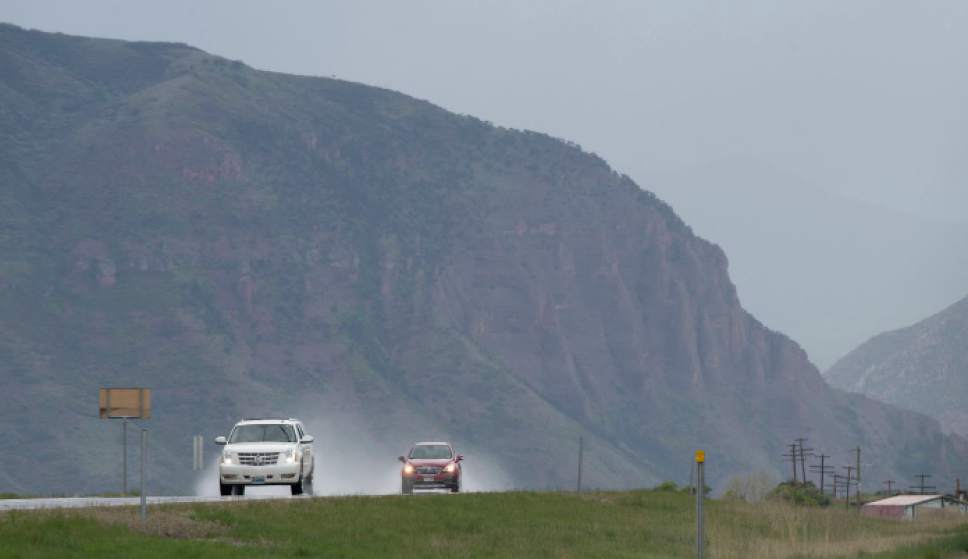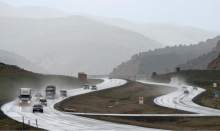This is an archived article that was published on sltrib.com in 2015, and information in the article may be outdated. It is provided only for personal research purposes and may not be reprinted.
Utah officials are proposing additional 80 mph speed-limit zones on rural freeways — plus increasing limits by 5 mph in some trickier sections to 70 or 75 mph.
That includes raising limits on most of Interstate 70 between the Colorado line and Interstate 15; on Interstate 84 from Riverdale to Echo Junction; and on Interstate 80 from Echo Junction to Wyoming.
With the addition of new 80 mph zones on I-70, "Now every interstate in Utah — with the exception of I-215 — will have at least some areas with an 80 mph zone," said Jason Davis, operations director for the Utah Department of Transportation.
UDOT officials outlined their plans to the Utah Transportation Commission on Thursday and are starting to consult with cities, counties and the Utah Highway Patrol.
Davis said the plans could change. But if others do not raise major objections, he said, the new speed zones could be put in place as early as the next few weeks.
Based on past experience, Davis does not expect actual average speeds to go up much even with the higher limits. Past studies showed that similar increases raised actual average speeds by only 1 to 2 mph, and they even decreased in some areas.
UDOT studies in areas that are now proposed for higher limits show that 85 percent of motorists often are traveling faster than the posted limit, Davis said, so the higher limit will more closely match the reality of current driving patterns.
"It will bring a more uniform flow of traffic," said Davis, adding that accidents occur when some vehicles travel much slower or much faster than other traffic.
Boosting the speed limit allows "some of the slow ones to travel 5 mph faster, and come up to the new posted limit. That should smooth the traffic flow," Davis said. "People tend to travel at the speed they are comfortable with and feel safe. Posted speed limits actually are less of a factor" in determining speed.
Most of I-70 between Colorado and I-15 is proposed to have an 80 mph limit, but some sections would be 75 — and one small section, where the road winds through canyons, would be 60 mph. Davis said traffic already moves that slowly in that area because of twists, and UDOT wants the limit to match behavior.
All of I-80 from Echo Junction to Wyoming is proposed to have 80 mph limits.
Interstate 84 between Riverdale and Echo Junction would have some sections that would increase to 70 or 75 mph — but none would jump to 80 mph. Some trickier sections will continue to have a 65 mph limit.
UDOT is proposing to raise the limit from 65 to 70 mph from Riverdale to the mouth of Weber Canyon. The agency wants to raise the limit to 75 mph between Mountain Green and Morgan, and in another section between Devil's Slide and Echo Junction.
After experimenting with 80-mph speed zones for several years on stretches of I-15 in southern Utah, the Legislature in 2013 passed a law allowing UDOT to raise limits up to 80 mph wherever studies show it likely would be safe.
With that law, UDOT added 289 miles of 80 mph speed limits in 2013. Then, late last year, it boosted the speed limit on most urban interstates from 65 to 70 mph.
While the increase on urban highways was controversial, UDOT released a study earlier this month saying actual speeds there have remained about the same. The average increased by up to 2 mph in some sections, and dropped by 2 mph in others.
Highway deaths have increased by about a third this year, but UDOT has said higher speed limits are not to blame.
Only a handful of fatalities occurred on highways with speed limits of 70 mph or higher, officials said, and more deaths actually occurred on roads with speed limits of 25 mph.
UDOT has blamed the higher number of deaths on people failing to wear seat belts — noting more than half those killed had failed to buckle up — and on distracted driving.
When Utah first adopted permanent 80 mph limits, Texas was the only other state allowing such fast speeds on any roads. Now, Idaho, Colorado, Wyoming and South Dakota have all opened the throttle.









